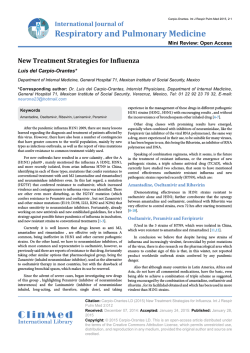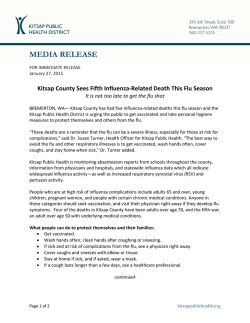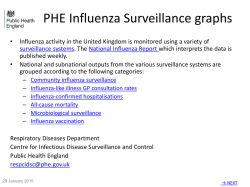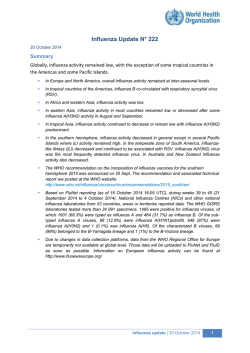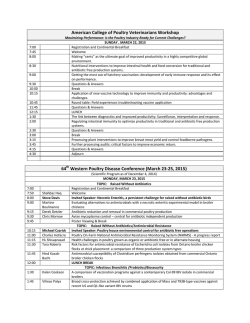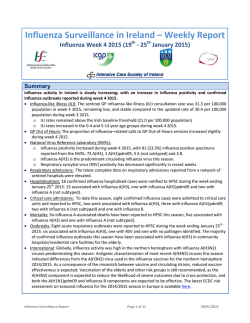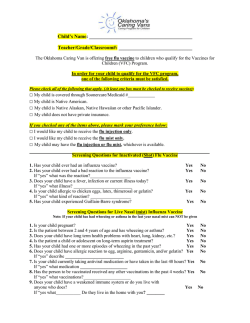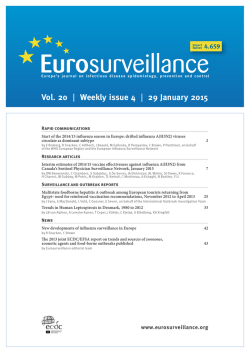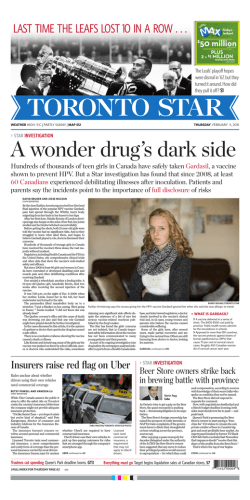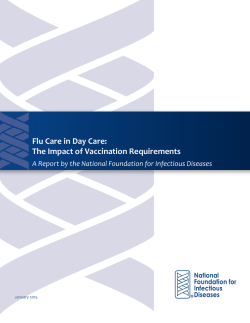
Low effectiveness of seasonal influenza vaccine
Rapid communications Low effectiveness of seasonal influenza vaccine in preventing laboratory-confirmed influenza in primary care in the United Kingdom: 2014/15 mid–season results R G Pebody ([email protected])1, F Warburton1, J Ellis2, N Andrews1, C Thompson2, B von Wissmann3, H K Green1, S Cottrell 4 , J Johnston5, S de Lusignan6, C Moore7, R Gunson8, C Robertson9,10, J McMenamin3, M Zambon2 1. Public Health England Centre of Infectious Disease Surveillance and Control, London, United Kingdom 2. Public Health England Operations Directorate, Microbiology Services, Colindale, London, United Kingdom 3. Health Protection Scotland, Glasgow, United Kingdom 4. Public Health Wales, Cardiff, United Kingdom 5. Public Health Agency Northern Ireland, Belfast, United Kingdom 6. Royal College of General Practitioners Research and Surveillance Centre, United Kingdom 7. Public Health Wales Molecular Diagnostics Unit, Cardiff, United Kingdom 8. West of Scotland Specialist Virology Centre, Glasgow, United Kingdom 9. University of Strathclyde, Glasgow, United Kingdom 10.International Prevention Research Institute, Lyon, France Citation style for this article: Pebody RG, Warburton F, Ellis J, Andrews N, Thompson C, von Wissmann B, Green HK, Cottrell S, Johnston J, de Lusignan S, Moore C, Gunson R, Robertson C, McMenamin J, Zambon M. Low effectiveness of seasonal influenza vaccine in preventing laboratory-confirmed influenza in primary care in the United Kingdom: 2014/15 mid–season results. Euro Surveill. 2015;20(5):pii=21025. Available online: http://www.eurosurveillance.org/ViewArticle.aspx?ArticleId=21025 Article submitted on 30 January 2015 / published on 05 February 2015 In 2014/15 the United Kingdom experienced circulation of influenza A(H3N2) with impact in the elderly. Midseason vaccine effectiveness (VE) shows an adjusted VE of 3.4% (95% CI: −44.8 to 35.5) against primary care consultation with laboratory-confirmed influenza and −2.3% (95% CI: −56.2 to 33.0) for A(H3N2). The low VE reflects mismatch between circulating viruses and the 2014/15 northern hemisphere A(H3N2) vaccine strain. Early use of antivirals for prophylaxis and treatment of vulnerable populations remains important. We present the 2014/15 mid-season estimates of influenza vaccine effectiveness (VE) for the United Kingdom of England, Wales, Scotland and Northern Ireland (UK). This season is dominated by early circulation of influenza A(H3N2) virus, and an overall VE in preventing medically attended laboratory-confirmed influenza in primary care of only 3.4% and against A(H3N2) of −2.3%. This report provides clear evidence of antigenic and genetic mismatch between circulating A(H3N2) viruses and the respective 2014/15 northern hemisphere vaccine strain. Background The UK has a long-standing selective influenza immunisation programme targeted at individuals at higher risk of severe disease, in particular all those 65 years and above and under 65-year olds in a clinical risk group, using inactivated trivalent influenza vaccine. The 2014/15 season is the second year where intranasally administered live attenuated influenza vaccine (LAIV) has been offered to pre-school age children in the UK with certain areas also vaccinating children of school-age [1]. This winter has been characterised by www.eurosurveillance.org early influenza activity, with A(H3N2) virus the dominant circulating sub-type. In England, by week 4 2015 peak influenza activity levels had exceeded those seen in the past three seasons, but not approached the peak levels seen in 2010/11 and 2008/09 [2]. The current season has led to large numbers of care home outbreaks, often in highly vaccinated populations, hospitalisations and significant excess all-cause mortality in the over 65 year-old population. The UK has well established methods to produce midand end-of-season estimates of VE in preventing primary care consultation due to laboratory-confirmed influenza infection [3,4]. The key aims of the present study were to provide early estimates of influenza VE in the UK to inform influenza prevention and control measures both for the remainder of this season and the forthcoming World Health Organization (WHO) convened meeting at the end of February, where vaccine composition is decided for the forthcoming northern hemisphere 2015/16 season. Study population and period Data were derived from five primary care influenza sentinel swabbing surveillance schemes from England (two schemes), Scotland, Wales and Northern Ireland. Details of the Royal College of General Practitioners (RCGP), Public Health England (PHE) Specialist Microbiology Network (SMN), Public Health Wales, Public Health Agency (PHA) of Northern Ireland and Health Protection Scotland (HPS) swabbing schemes have been published previously [4]. 1 The study period ran from 1 October 2014 to 16 January 2015. Patients were swabbed as part of clinical care, with verbal consent. Cases were defined as persons presenting during the study period in a participating general practitioner (GP) practice with an acute influenza-like-illness (ILI) who were swabbed and then tested positive for influenza A or B viruses. An ILI case was defined as an individual presenting in primary care with an acute respiratory illness with physiciandiagnosed fever or complaint of feverishness. Controls were individuals presenting with ILI in the same period that were swabbed and tested negative for influenza. A standardised questionnaire was completed by the GP responsible for the patient during the consultation. Demographic, clinical and epidemiological information was collected from cases and controls, including date of birth, sex, pre-defined underlying clinical risk group, date of onset of respiratory illness, date of specimen collection, and influenza vaccination status for the 2014/15 season, with vaccination dates and route of administration (injection/intranasal) and whether resident in an area where a primary school vaccination programme was in operation. Laboratory analysis Laboratory confirmation was undertaken using comparable methods with real-time polymerase chain reaction (RT-PCR) assays capable of detecting circulating influenza A and influenza B viruses and other respiratory viruses [5,6]. Samples were sent to respective laboratories as previously described [4]. Further strain characterisation was also performed; influenza viruses were isolated in MDCK or MDCK-SIAT1 cells from RT-PCR positive samples from England as previously described [7,8]. Influenza A(H3N2) virus isolates with a haemagglutination titre ≥ 40 were characterised antigenically using post-infection ferret antisera in haemagglutination inhibition (HI) assays, with guinea pig red blood cells [9]. Nucleotide sequencing of the haemagglutinin (HA) gene of a subset of influenza A(H3N2) viruses selected to be representative of the range of patient’s age, date of sample collection, geographical location, and antigenic characterisation of the influenza A(H3N2) virus isolate, if performed, was undertaken (primer sequences available on request), and phylogenetic trees were constructed with a neighbour-joining algorithm available in the Mega 6 software (http://www. megasoftware.net) [10]. HA sequences from reference strains used in the phylogenetic analysis were obtained from the EpiFlu database of the Global Initiative on Sharing Avian Influenza Data (GISAID) (Table 1). missing date of onset or an onset date more than seven days before the swab was taken were also excluded. VE was estimated by the test negative case control (TNCC) design. In this design, VE is calculated as 1-(odds ratio) obtained using multivariable logistic regression models with influenza PCR results and seasonal vaccination status as the linear predictor. VE was also estimated for influenza A only and for A(H3N2); Influenza A(H1N1) and B numbers were too small to examine. In the analyses evaluating VE for a specific type or strain, those positive for other types were excluded. Age (coded into four standard age groups, < 18, 18–44, 45–64 and ≥ 65 years), sex, clinical risk group, surveillance scheme (RCGP, SMN, HPS, Wales, Northern Ireland), residence in an area where primary school age vaccination programme operated and date of onset (month) were investigated as potential confounding variables. All statistical analyses were carried out in Stata version 13 (StataCorp, College Station, Texas). Results A total of 2,278 individuals were swabbed in primary care during the study period and had a laboratory result available. The reasons for study inclusion and exclusion are outlined in Figure 1. Five persons were excluded because the influenza virus detected in them was a LAIV vaccine strain based either on sequence analysis or inferred based on influenza co-infection. The details of the 1,341 individuals remaining in the study were stratified according to the swab result Figure 1 Flowchart showing specimen inclusion and exclusion criteria, interim 2014/15 influenza vaccine effectiveness evaluation, United Kingdom, week 40 2014 to week 3 2015 Total number of specimens in original dataset (N=2,278) (n=101) Sequentially excluded samples Date of sample prior to 1 Oct 2014 (n=101) (n=6) unknown (n=6) Influenza status Live attenuated influenza vaccine strain (n=5) Vaccination status unknown (n=80) (n=5) Date of vaccination not known (n=107) Vaccination less than 14 days from illness onset (n=67) Date of illness onset unknown (n=178) (n=178) Swab more(n=80) than seven days after illness onset (n=393) Statistical analysis Persons were defined as vaccinated if the date of vaccination with the 2014/15 seasonal influenza vaccine was 14 or more days before onset of illness. Those in whom the period between vaccination and onset of illness was less than 14 days were excluded, as were those where date of vaccination was missing. Those with a 2 (n=107) Samples included in the analysis N=1,341 Cases N=312 (n=67) Controls N=1,029 www.eurosurveillance.org Table 1 Details for influenza A and B cases and controls, United Kingdom, week 40 2014 to week 3 2015 (1,029 controls and 312 cases) Controls Influenza B cases Influenza A a cases Influenza A(H1N1) pdm09 cases Influenza A(H3N2) cases (n = 1,029) (n = 16) (n = 296) (n = 14) (n = 271) n (%) n (%) n (%) n (%) n (%) < 18 269(79.8) 3(0.9) 65(19.3) 2(0.6) 60(17.8) 18–44 412(76.7) 7(1.3) 118(22) 6(1.1) 106(19.7) 45–64 244(74.8) 5(1.5) 77(23.6) 6(1.8) 69(21.2) 65 + 104(74.3) 1(0.7) 35(25) 0(0) 35(25) 0(0) 0(0) 1(100) 0(0) 1(100) P-valueb Age group (years) Missing information 0.40 Sex Female 592(77.2) 8(1) 167(21.8) 9(1.2) 153(19.9) Male 432(76.3) 8(1.4) 126(22.3) 5(0.9) 115(20.3) 5(62.5) 0(0) 3(37.5) 0(0) 3(37.5) Missing information 0.71 Scheme Northern Ireland 29(87.9) 1(3) 3(9.1) 0(0) 3(9.1) RCGP (England) 374(67) 6(1.1) 178(31.9) 10(1.8) 168(30.1) SMN (England) 138(77.1) 2(1.1) 39(21.8) 2(1.1) 32(17.9) Scotland 466(87.6) 7(1.3) 59(11.1) 2(0.4) 51(9.6) Wales 22(56.4) 0(0) 17(43.6) 0(0) 17(43.6) No 710(76.5) 15(1.6) 203(21.9) 10(1.1) 188(20.3) Yes 215(76.2) 0(0) 67(23.8) 1(0.4) 63(22.3) Missing information 104(79.4) 1(0.8) 26(19.8) 3(2.3) 20(15.3) <0.001 Risk group 0.93 Interval onset to swab (days) 0–1 140(69.7) 1(0.5) 60(29.9) 2(1) 56(27.9) 2–4 498(74) 10(1.5) 165(24.5) 8(1.2) 149(22.1) 5–7 391(83.7) 5(1.1) 71(15.2) 4(0.9) 66(14.1) 210(19.1) <0.001 Vaccination status and route Unvaccinated 852(77.5) 15(1.4) 232(21.1) 13(1.2) Vaccinated 177(73.1) 1(0.4) 64(26.4) 11(4.5) 61(25.2) Injection 138(72.6) 1(0.5) 51(26.8) 0(0) 49(25.8) Intranasal 23(79.3) 0(0) 6(20.7) 1(3.4) 5(17.2) Missing route 16(69.6) 0(0) 7(30.4) 0(0) 7(30.4) 0.14c Primary school age vaccination programme No 289(67.5) 4(0.9) 135(31.5) 10(2.3) 121(28.3) Yes 726(81.3) 12(1.3) 155(17.4) 4(0.4) 144(16.1) 14(70) 0(0) 6(30) 0(0) 6(30) Missing information <0.001 Month of event Oct 2014 217(95.6) 3(1.3) 7(3.1) 1(0.4) 5(2.2) Nov 2014 343(94.2) 6(1.6) 15(4.1) 0(0) 15(4.1) Dec 2014 375(64.1) 4(0.7) 207(35.4) 6(1) 195(33.3) Jan 2015 94(57.3) 3(1.8) 67(40.9) 6(3.7) 56(34.1) <0.001 RCGP: Royal College of General Practitioners’ surveillance scheme; SMN: Specialist Microbiology Network. a There were 11 cases of influenza A infection where the subtype was unknown. b Controls vs any influenza case. c Vaccinated vs unvaccinated. www.eurosurveillance.org 3 (Table 1). Positivity rates differed significantly by month, scheme and primary school age vaccination programme area. Influenza A(H3N2) strain characterisation During the study period, a total of 127 A(H3N2) circulating viruses were isolated from all referred clinical samples and antigenically characterised by HI analysis. The majority of A(H3N2) viruses analysed (100/127; 79%) were antigenically similar to the A(H3N2) virus component of the 2014/15 northern hemisphere vaccine A/Texas/50/2012 (≤ 4-fold difference) with antiserum raised against A/Texas/50/2012 in antigenic characterisation by HI); however a proportion of A(H3N2) viruses (21%) showed reduced reactivity (> 4-fold difference) (Table 2). These viruses were antigenically similar to A/ Switzerland/9715293/2013, the recommended A(H3N2) component of the 2015 southern hemisphere vaccine. A > 4-fold difference in HI assay titres with reference antiserum is considered to be significant antigenic drift. Of the 44 UK influenza A(H3N2) viruses analysed to date by sequencing, the HA genes of these viruses belonged in the genetic clade 3C, as does the 2014/15 A(H3N2) vaccine strain A/Texas/50/2012 and A/Switzerland/9715293/2013, one of the three recommended strains for the southern hemisphere 2015 vaccine composition. However, the majority (35/44; 79.5%) of the HA sequences of 2014/15 UK viruses analysed were further characterised within this clade to belong in subgroup 3C.2a of group 3C.2, with fewer (9/44 17.3%) in group 3C.3 (Figure 2). These groups are considered genetically distinct from the 2014/15 A/ Texas/50/2012(H3N2)-like clade 3C.1 vaccine reference strain. Model fitting for vaccine effectiveness estimation When estimating vaccine effectiveness, age group, sex, month of onset, surveillance scheme and primary school age programme area were adjusted for in a multivariable logistic regression model. Only surveillance scheme, time period and primary school age programme area were significantly associated with having a positive swab, and all were confounders for Table 2 Influenza A(H3N2) viruses isolated from specimens with < 4-fold, 4-fold, or > 4-fold difference in haemagglutination inhibition (HI) assay titres compared with A/Texas/50/2012, the 2014/15 northern hemisphere influenza seasonal A(H3N2) influenza vaccine component, United Kingdom, week 40 2014 to week 3 2015 (n = 127) Influenza virus A(H3N2) 4 Change in reactivity with A/Texas/50/2012 antiserum <4-fold 4-fold >4-fold Total N (%) n (%) N (%) n (%) 65 51.2 35 27.6 27 21.3 127 100 vaccine effectiveness (changing the estimate by more than 5%). Information on risk group was missing for 131 samples (9.8%) and was therefore not included in the final model. If risk group was included, it was found not to be associated with being positive and the VE estimates remained similar. Table 3 shows vaccine effectiveness estimates against all influenza, influenza A and influenza A(H3N2). There were inadequate samples to enable estimation of effectiveness against influenza A(H1N1)pdm09 or influenza B. The adjusted VE of influenza vaccine against all influenza was 3.4% and was very similar for A(H3N2), reflecting the fact that A(H3N2) is the dominant circulating virus strain this season. Discussion This paper presents the mid-season estimates of influenza vaccine effectiveness for the UK. In a season dominated by early circulation of influenza A(H3N2) virus, we found the overall VE in preventing medically attended laboratory-confirmed influenza in primary care was only 3.4% and −2.3% specifically against A(H3N2). We also found clear evidence of antigenic and genetic mismatch between circulating A(H3N2) viruses and the 2014/15 northern hemisphere vaccine strain. The UK, together with other European countries, the United States, Canada and Australia has well established systems to generate interim estimates of seasonal influenza VE. These early results are used to optimise in-season control and prevention measures, to inform other countries where the influenza season may have just started or is about to start, and to contribute to forthcoming WHO vaccine composition deliberations. The UK, as observed in North America and some other European countries [11,12] has experienced a season dominated by early circulation of influenza A(H3N2) virus – with clear evidence of emergence of a drifted A(H3N2) strain, first seen in North America in spring 2014 [11], and then in Australia in mid-2014 [13]. This drifted strain has reduced antigenic reactivity with antiserum raised to the current A(H3N2) vaccine strain (A/Texas/50/2012), and is antigenically more closely related to A/Switzerland/9715293/2013, the A(H3N2) virus selected as one of the three recommended components for the 2015 southern hemisphere influenza vaccine [14]. Characterisation of circulating influenza viruses involves both genetic and antigenic characterisation. Genetic analysis focusses on detailed comparison of the HA genes of viruses, tracking changes over time and linking this to phylogenetic analysis of sequence clustering to determine emerging virus groups and changes in receptor binding and other important antigenic epitopes. Genetic variation does not always correlate with antigenic variation. The interpretation of both data sources is complex, as not all viruses www.eurosurveillance.org Figure 2 Phylogenetic analysis with sequences of the HA1 subunit of the haemagglutinin (HA) gene from reference viruses downloaded from the GISAID EpiFlu database and influenza A(H3N2) sequences derived from patients in the United Kingdom, week 40 2014 to week 3 2015 A/England/44840069/2014 A/England/44940038/2014 A/England/529/2014 A/England/44840067/2014 A/England/44780079/2014 A/Scotland/426161/2014 A/England/44160198/2014 A/England/44160199/2014 A/England/511/2014 A/England/44160201/2014 A/England/44160202/2014 A/England/512/2014 A/England/507/2014 A/England/43020765/2014 A/England/45040065/2014 A/England/45000006/2014 A/England/45100196/2014 A/England/44860850/2014 A/England/44020584/2014 A/England/44060047/2014 A/England/44320794/2014 A/Scotland/426901/2014 A/England/44320795/2014 A/England/44840003/2014 A/England/45040069/2014 A/Scotland/426752/2014 A/England/44760132/2014 A/England/525/2014 A/England/45060041/2014 A/England/45000008/2014 A/England/45080158/2014 A/Scotland/426918/2014 A/England/45000028/2014 A/England/44540273/2014 3C.2a 3C.2 A/England/43400390/2014 A/England/45000010/2014 A/England/43320581/2014 A/England/43860187/2014 A/England/45060049/2014 A/England/44080181/2014 A/HongKong/5738/2014 A/England/43700330/2014 A/England/671/2013 A/England/370/2014 A/England/40180189/2014 A/England/41180423/2014 A/England/35120047/2013 3C A/Norway/1903/2014 A/Switzerland/9715293/2014 A/England/43460207/2014 3C.3a A/England/479/2014 A/Samara/73/2013 A/England/41860057/2014 A/England/44640016/2014 A/England/498/2014 A/England/34560054/2013 A/England/41500098/2014 A/England/40280202/2014 A/England/420/2014 A/England/41800221/2014 A/England/41420344/2014 A/England/2/2014 A/Scotland/425954/2014 A/England/513/2014 A/England/43920370/2014 A/England/298/2014 A/England/34500001/2013 A/England/43860188/2014 A/England/41420350/2014 3C.3 A/Scotland/426685/2014 A/England/44320793/2014 A/England/41060123/2014 A/England/655/2013 A/England/41800219/2014 A/Texas/50/2012 3C.1 A/England/516/2014 A/England/45000025/2014 A/England/533/2014 A/England/534/2014 A/England/536/2014 A/Victoria/361/2011 A/Athens GR11/22012 3B A/Stockholm/18/2011 3A A/Perth/16/2009 0.002 GISAID: Global Initiative on Sharing Avian Influenza Data. www.eurosurveillance.org 5 Table 3 Samples positive (cases) and negative (controls) for influenza according to vaccination status and vaccine effectiveness estimates, United Kingdom, week 40 2014 to week 3 2015 Cases (vaccinated : unvaccinated) All influenza (A and B) 65 : 247 All influenza A 64 : 232 Influenza A(H3N2) only 61 : 210 Controls (vaccinated : unvaccinated) Crude VE (95% CI) −26.7% (−74.0 to 7.8) 3.4% (−44.8 to 35.5) 177 : 825 −32.2% (−82.2 to 4.0) −0.7% (−52.0 to 33.2) −39.8% (−94.1 to −0.7) −2.3% (−56.2 to 33.0) Adjusteda VE (95% CI) CI: confidence interval; VE: vaccine effectiveness. a Adjusted for age group, sex, month, surveillance scheme and primary school area. can be cultivated in sufficient quantity for antigenic characterisation, so that viruses for which sequence information is available may not be antigenically characterised, leading to potential bias in interpretation. This is particularly relevant to the discussion of antigenic characterisation data for A(H3N2) viruses in the 2014/15 winter season. Some circulating A(H3N2) viruses are difficult to grow in tissue culture as a result of genetic drift affecting receptor binding properties [15], and viruses grown in eggs may have egg adaptive changes which make the analysis of antigenic drift complex. Most A(H3N2) strains seen since February 2014 fell into the HA genetic clade (3C) for which A/ Switzerland/9715293/2013 was a prototype representative strain. Antigenic and genetic characterisation data indicate that A/Switzerland/9715293/2013-like strains have circulated in the UK during winter 2014/15. There is a clear antigenic mismatch between the northern hemisphere H3N2 vaccine strain and the circulating variant in winter of 2014/15. The full picture of virological variation requires further detailed analysis, not possible at this stage of the 2014/15 season. Our observation of an absence of significant effectiveness in preventing medically-attended laboratoryconfirmed influenza in primary care due to A(H3N2) are congruent with the findings recently reported from the US [16] who report low effectiveness of 22% (95% confidence interval (CI): 5–35) and from Canada who report a VE of −8% (95% CI: −50 to 23) against laboratoryconfirmed, medically-attended influenza A(H3N2) virus infection in primary care [17]. The observation of low or non-significant effectiveness in 2014/15 in the UK and in North America correlates with the direct mismatch seen between the vaccine virus and A(H3N2) strains circulating this winter. Vaccine mismatch due to circulation of drifted strains does occasionally occur, although this is the lowest estimate of influenza VE reported by the UK over the past decade using the TNCC approach to measure VE [3,4]. It is also important to highlight the uncertainty of our estimate. The upper 95% CI of 35% shows we can be confident that VE is low at this point although we cannot be clear that influenza vaccine has no effectiveness this season. Indeed the significantly lower influenza positivity in areas where children of school age were vaccinated compared to non-pilot areas (Table 1) is suggestive of 6 a possible impact of the childhood influenza vaccination programme. Furthermore, this mid-season analysis does not preclude the likelihood that the vaccine should offer protection from different types of influenza, such as influenza B that may still circulate later in the season. All these elements will form part of the end-of-season analysis including stratification by agegroup and scheme. The WHO has made their recommendations for the composition of the influenza vaccine for the 2015 southern hemisphere winter in September 2014, including a switch to a A/Switzerland/9715293/2013 (H3N2)-like virus [18]. The WHO influenza vaccine composition group will convene shortly, at the end of February 2015, to consider recommendations for the forthcoming northern hemisphere 2015/16 winter, and the findings in this paper will contribute to their deliberations. The observation of low vaccine effectiveness this season highlights the vital importance of implementing other prevention and control measures for the remainder of this season, in particular the early use of influenza antivirals for post-exposure prophylaxis and treatment of vulnerable populations, such as the elderly, together with appropriate infection control measures. Acknowledgements We are grateful to the many primary care physicians in England, Wales, Northern Ireland and Scotland who supplied the clinical information on their patients; to the staff of the PHE Respiratory Virus Unit, the PHE Specialist Microbiology Laboratories, Public Health Wales Specialist Virology Centre, the West of Scotland Specialist Virology Centre and the Regional Virus Laboratory, Belfast who undertook analysis of specimens. We thank the staff of PHE, RCGP, Public Health Wales, Public Health Agency Northern Ireland and Health Protection Scotland teams who coordinate the GP schemes, in particular Abigail Sunderland and Praveen SebastianPillai from PHE; Richard Lewis and Hannah Evans from PHW; Catherine Frew, Alasdair MacLean, Samantha Shepherd & Celia Aitken from WoSSVC and Arlene Reynolds, Diogo Marques, Louise Primrose-Shaw and Karen Voy from HPS for overseeing data collection, and Ivelina Yonova (Practice Liaison), Sameera Pathirannehelage (SQL Developer), and David Mullett (Information Systems Manager) from RCGP/ University of Surrey. We acknowledge the originating and submitting laboratories of the sequences from GISAID’s EpiFlu Database on which some of the analyses are based (see Figure 2). All submitters of data may be contacted directly via the GISAID website www.gisaid.org www.eurosurveillance.org Conflicts of interest None declared. Authors’ contributions RGP wrote the first draft; FW and NA led on the statistical analysis; all co-authors contributed epidemiological and/ or virological data, contributed to the interpretation of the results, reviewed the early draft and approved the final version. 1990;8(1):737-87. http://dx.doi.org/10.1146/annurev. iy.08.040190.003513 PMID:2188678 16. Flannery B, Clippard J, Zimmerman RK, Nowalk MP, Jackson ML, Jackson LA, et al. Early estimates of seasonal influenza vaccine effectiveness - United States, january 2015. MMWR Morb Mortal Wkly Rep. 2015;64(1):10-5. PMID:25590680 17. Skowronski DM, Chambers C, Sabaiduc S, De Serres G, Dickinson JA, Winter AL, et al. Interim estimates of 2014/15 vaccine effectiveness against influenza A(H3N2) from Canada’s Sentinel Physician Surveillance Network, January 2015. Euro Surveill. 2015;20(4):21022. 18. World Health Organization (WHO). Recommended composition of influenza virus vaccines for use in the 2015 southern hemisphere influenza season. Geneva: WHO; 22-24 Sept 2014. Available from: http://www.who.int/influenza/vaccines/virus/ recommendations/consultation201409/en/ References 1. Department of Health. Public Health England. The national flu immunisation programme 2014/15. London: Public Health England. 28 Apr 2014. Available from: https://www.gov.uk/ government/uploads/system/uploads/attachment_data/ file/316007/FluImmunisationLetter2014_accessible.pdf 2. Public Health England (PHE). PHE Weekly National Influenza Report – week 4 report. London: PHE. 22 Jan 2015. Available from: https://www.gov.uk/government/uploads/system/ uploads/attachment_data/file/397454/Weekly_report_ current_week_4x.pdf 3. Fleming DM, Andrews NJ, Ellis JS, Bermingham A, Sebastianpillai P, Elliot AJ, et al. Estimating influenza vaccine effectiveness using routinely collected laboratory data. J Epidemiol Community Health. 2010;64(12):1062-7. http:// dx.doi.org/10.1136/jech.2009.093450 PMID:19910645 4. Andrews N, McMenamin J, Durnall H, Ellis J, Lackenby A, Robertson C, et al. Effectiveness of trivalent seasonal influenza vaccine in preventing laboratory-confirmed influenza in primary care in the United Kingdom: 2012/13 end of season results. Euro Surveill. 2014;19(27): 20851. http://dx.doi. org/10.2807/1560-7917.ES2014.19.27.20851 PMID:25033051 5. Ellis J, Iturriza M, Allen R, Bermingham A, Brown K, Gray J, et al. Evaluation of four real-time PCR assays for detection of influenza A(H1N1)v viruses. Euro Surveill. 2009;14(22):19230. PMID:19497254 6. Gunson R, Maclean A, Davies E, Bennett S, Miller R, Carman WF. Development of a multiplex real-time RT-PCR that allows universal detection of influenza A viruses and simultaneous typing of influenza A/H1N1/2009 virus. J Virol Methods. 2010;163(2):258-61. http://dx.doi.org/10.1016/j. jviromet.2009.10.006 PMID:19854220 7. Galiano M, Agapow P-M, Thompson C, Platt S, Underwood A, Ellis J, et al. Evolutionary pathways of the pandemic influenza A (H1N1) 2009 in the UK. PLoS ONE. 2011;6(8):e23779. http:// dx.doi.org/10.1371/journal.pone.0023779 PMID:21887318 8. Matrosovich M, Matrosovich T, Carr J, Roberts NA, Klenk HD. Overexpression of the alpha-2,6-sialyltransferase in MDCK cells increases influenza virus sensitivity to neuraminidase inhibitors. J Virol. 2003;77(15):8418-25. http://dx.doi. org/10.1128/JVI.77.15.8418-8425.2003 PMID:12857911 9. Zambon M. Laboratory Diagnosis of Influenza. In: Nicholson K, Hay A, Webster RG, editors. Textbook of Influenza. Oxford: Blackwell Science; 1998. pp. 291-313]. 10. Tamura K, Stecher G, Peterson D, Filipski A, Kumar S. MEGA6: Molecular Evolutionary Genetics Analysis version 6.0. Mol Biol Evol. 2013;30(12):2725-9. http://dx.doi.org/10.1093/molbev/ mst197 PMID:24132122 11. Centers for Disease Prevention and Control (CDC). CDC Health Advisory Regarding the Potential for Circulation of Drifted Influenza A (H3N2) Viruses. Atlanta: CDC. 3 Dec 2014. Available from: http://emergency.cdc.gov/HAN/han00374.asp 12. Broberg E, Snacken R, Adlhoch C, Beauté J, Galinska M, Pereyaslov D, et al. Start of the 2014/15 influenza season in Europe: drifted influenza A(H3N2) viruses circulate as dominant subtype. Euro Surveill. 2015;20(4):pii=21023. Available from: http://www.eurosurveillance.org/ViewArticle. aspx?ArticleId=21023 13. World Health Organization (WHO). Review of the 2014 influenza season in the southern hemisphere. Wkly Epidemiol Rec. 2014;89(48):529-41. 14. ECDC Circulation of drifted influenza A(H3N2) viruses in the EU/ EEA http://ecdc.europa.eu/en/publications/Publications/RRAInfluenzaA-H3N2-Dec-2014.pdf 15. Wilson IA, Cox NJ. Structural basis of immune recognition of influenza virus hemagglutinin. Annu Rev Immunol. www.eurosurveillance.org 7
© Copyright 2025
